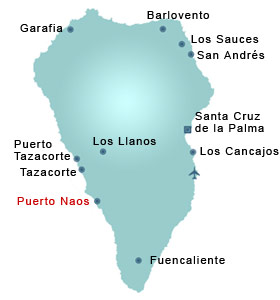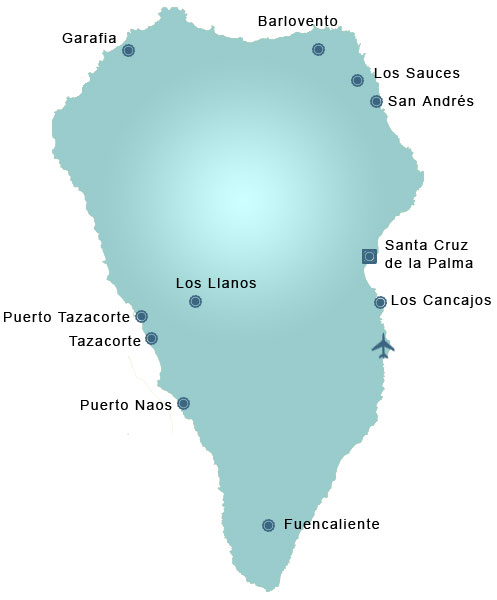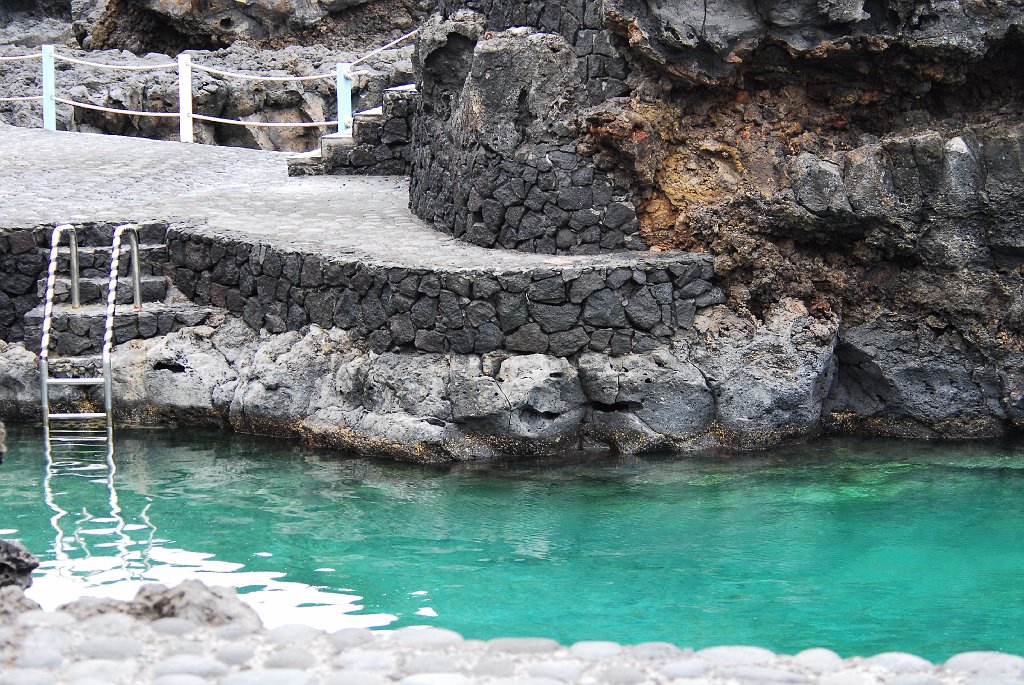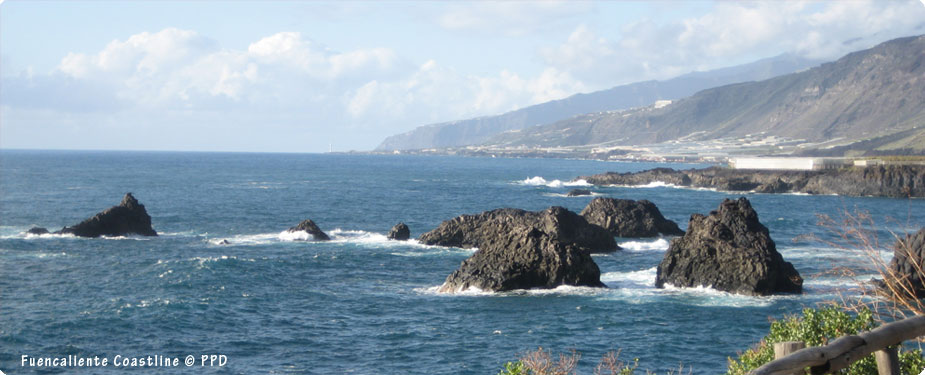- Santa Cruz de la Palma
- Garafia
- Barlovento
- San Andrés
- Charco Azul
- Los Cancajos
- Fuencaliente
- Puerto Naos
- Tazacorte & Puerto Tazacorte
- Los Llanos
Charco Azul
Highlights:
- Natural salt-water sea pools
- Swimming (seasonal)
Charco Azul is located slightly north of San Andres and offers a unique swimming experience with natural sea pools set in the rocks. The pools have been slightly modified to make them safer for swimming but the seabed is still visible at the base. The protection offered by the rocks gives the impression of being in the ocean but without the danger of being swept away.
The area was originally a well-kept secret and just used by islanders but is now a popular tourist attraction and a regular stop-off point for coach trips. Due to this, the area can be quite busy in the summer months.
Charco Azul also has restaurants, showers and sunbathing areas for visitors to use.
The town itself has a rum distillery which prospered until a short time ago because of the plentiful water supply and sugar cane grown in the nearby area. They principally produced Ron Aldea.
Honest Reviews by Outdoor Views
We visited Charco Azul during one of the Natours excursions and although it was a rather gloomy day in February and too cold for swimming, it was well worth the trip and is something that we have never seen before. The colours in the pools were amazing and offered a great photographic opportunity. Our visit was quite brief but enjoyable all the same and I can imagine it must be gorgeous on a hot summers day. A unique experience to remember.
Los Cancajos
Highlights: Beach Resort
- Black sand beach with sheltered bays
- Children’s play area
- Watersports
The popular beach resort of Los Cancajos is located on the east coast of the island between the airport and Santa Cruz de la Palma. It serves as the principal beach area and seaside town for the capital city.
As a relatively new resort, it offers most of the features you’d expect including hotels, bars and restaurants, grocery stores, sun loungers, showers, a children’s playground and a black sand beach situated in three sheltered bays. It’s a small holiday resort compared to some of the other Canary Islands but offers all you need in one place with easy access to other areas. The capital city is 4km away and it’s just a 10 minute drive to the airport.
Watersports are popular here and it’s known as one of the best places on the island to snorkel and dive. The beach at Los Cancajos has been awarded the Blue Flag for cleanliness and offers a safe environment for the whole family to enjoy.
Many coach excursions depart from here so you can easily pick up a tour to see the rest of the island. A regular bus service also runs frequently to Santa Cruz and other areas of the island.
Honest Reviews from Outdoor Views
Since we stayed on the west coast, our only views of Los Cancajos were from the coach window as we sat waiting to leave for our excursions but it looked like a busy little place that was a popular spot for tourism. There were hotels, shops, restaurants and bars all on offer together with a beach area for swimming etc which looked clean and tidy.
We generally preferred the more remote west side of the island but Los Cancajos had more to offer with regards facilities outside of the hotels and was in a good position for exploring the rest of the island. It is quite close to the airport but I think flights are rare!
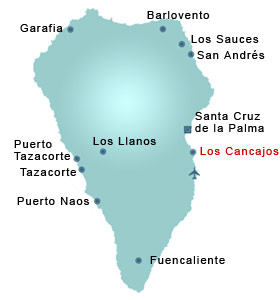
Fuencaliente
Highlights:
- Teneguia & San Antonio Volcanoes
- Good walking opportunities
- Fuencaliente Lighthouse
- Rugged coastal views
Fuencaliente is situated in the south of the island and is also known as Fuencaliente de la Palma. The main town, found in the higher region, is fairly small but has a few restaurants, bars and cafes together with a couple of supermarkets that offer all you need. Fuencaliente also has several small villages surrounding it including Las Indias and Los Canarios.
There’s not much to see if you are planning a day trip to be honest but the town has some interesting features and a church that dates from the early 18th Century.
The highlight and main attraction of the Fuencaliente area are the two volcanoes, Teneguía and San Antonio, which are well worth a visit and very popular with visitors to the island.
Fuencaliente’s rugged coastal areas are abundant with banana plantations and offer quiet black sand beaches and coves. Two lighthouses and a museum can be found on the southern tip of the island, an area called Punta Fuencaliente, which can be reached by car, bus or foot.
With the exception of the volcanoes, Fuencaliente is not a tourist area but because of this, it offers a quiet, peaceful, relaxing place to stay if you are looking for something more remote and away from it all and the coastal views are more impressive and rugged than the east coast.
Honest Reviews from Outdoor Views
We spent two weeks at the La Palma Princess Hotel on the Fuencaliente coastline which makes an ideal spot for a ‘get away from it all’ break. The hotel was good and if you are staying there, it’s easy to hop on the local bus, take an organised trip or hire a car to get around the island and overcome the remoteness if it gets too much!
The main point to make about Fuencaliente (and one of the reasons for this website) is that it’s an undeveloped area and there is not much around. We enjoyed the peace and quiet and nature but there were some holiday-makers at the hotel who weren’t prepared for it and didn’t like the location so bear this in mind. You only have to read some of the more negative Trip Advisor reviews to be put off but as long as you know what to expect, the hotel is a good choice in our opinion.
The town of Fuencaliente itself is quite small but upon further investigation, it had quite a bit of charm and some interesting buildings on offer. The surrounding area is quite varied with greenery and flowers in one part and volcanic rock in another and the volcanoes are definitely worth a trip. If you want a touristy beach resort with bars, restaurants and cash points on every corner, this is not for you.
You can read our full review of La Palma Princess Hotel which describes what we saw and what we thought in detail and also check our Hints & Tips page for some notes on the hotel.
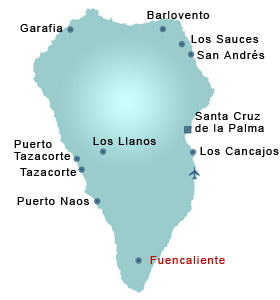
Puerto Naos
Highlights: Small Town & Beach
- Longest black sand beach on the island
- Good year-round climate
Puerto Naos is located on the south-west coast and has one of the best beaches on the island which is formed from ground volcanic rock. It belongs to the Los Llanos community.
Puerto Naos was originally a traditional fishing village and is still fairly undeveloped and small but is a popular tourist area due to the beach and the climate. It’s located in one of the sunniest and warmest parts of the island and is therefore a popular winter spot too.
The town consists mainly of apartments and also has a few streets away from the beach offering restaurants, bars, cafe and shops.
Situated approximately 45 minutes from the airport, 20 minutes from Los Llanos and the Caldera De taburiente a further short drive away, it is a fairly good centre from which to explore.
The back esplanade is the landing point for two paragliding flight routes.
